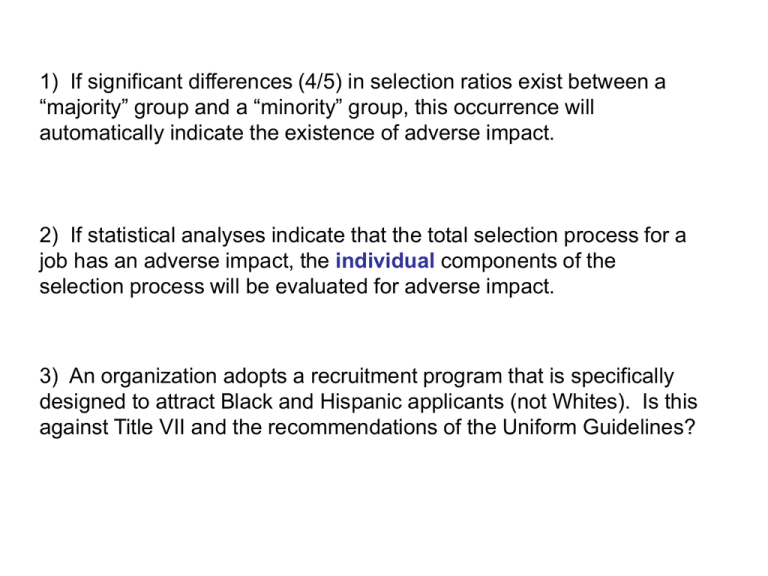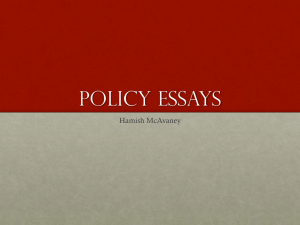
1) If significant differences (4/5) in selection ratios exist between a
“majority” group and a “minority” group, this occurrence will
automatically indicate the existence of adverse impact.
2) If statistical analyses indicate that the total selection process for a
job has an adverse impact, the individual components of the
selection process will be evaluated for adverse impact.
3) An organization adopts a recruitment program that is specifically
designed to attract Black and Hispanic applicants (not Whites). Is this
against Title VII and the recommendations of the Uniform Guidelines?
1) Adverse impact and the ``four-fifths rule.'' A selection rate for any race,
sex, or ethnic group which is less than four-fifths (4/5) (or eighty percent)
of the rate for the group with the highest rate will generally be regarded
by the Federal enforcement agencies as evidence of adverse impact,
while a greater than four-fifths rate will generally not be regarded by
Federal enforcement agencies as evidence of adverse impact.
Smaller differences in selection rate may nevertheless constitute
adverse impact, where they are:
• significant in both statistical and practical terms or
• where a user's actions have discouraged applicants disproportionately
on grounds of race, sex, or ethnic group.
1) Greater differences in selection rate may not constitute
adverse impact where the differences are:
• based on small numbers and are not statistically
significant, or
• Where special recruiting or other programs cause the pool
of minority or female candidates to be atypical of the normal
pool of applicants from that group.
Where the user's evidence concerning the impact of a
selection procedure indicates adverse impact but is based
upon numbers which are too small to be reliable,
evidence concerning the impact of the procedure over a
longer period of time and/or evidence concerning the impact
which the selection procedure had when used in the same
manner in similar circumstances elsewhere may be
considered in determining adverse impact.
2) If the selection process for a job has an adverse impact, the individual
components of the selection process should be evaluated for adverse impact.
If this information shows that the total selection process does not have an
adverse impact, the Federal enforcement agencies, in the exercise of their
administrative and prosecutorial discretion, in usual circumstances, will not
expect a user to evaluate the individual components for adverse impact, or to
validate such individual components …
Two exceptions:
• Where the selection procedure is a significant factor in the continuation of
patterns of assignments of incumbent employees caused by prior discriminatory
employment practices,
• Where the weight of court decisions or administrative interpretations hold that a
specific procedure is not job related in the same or similar circumstances.
3) These guidelines apply only to selection procedures which
are used as a basis for making employment decisions. For
example, the use of recruiting procedures designed to attract
members of a particular race, sex, or ethnic group, which were
previously denied employment opportunities or which are currently
underutilized, may be necessary to bring an employer into
compliance with Federal law, and is frequently an essential
element of any effective affirmative action program; but
recruitment practices are not considered by these guidelines to
be selection procedures.
Affirmative action obligations. The use of selection procedures
which have been validated pursuant to these guidelines does not
relieve users of any obligations they may have to undertake
affirmative action to assure equal employment opportunity.
Nothing in these guidelines is intended to preclude the use of
lawful selection procedures which assist in remedying the effects
of prior discriminatory practices, or the achievement of affirmative
action objectives.
4) A company must collect data on adverse impact for minority groups that
represent at least 10% of the available labor pool. True of false?
5) A company must comply with the guidelines of Title VII if it has at least
10 full-time employees. True of false?
6) Private membership clubs must comply with the guidelines included in
Title VII? True of false?
7) If a seniority program leads to a bias in the hiring or promotion of
minorities, it is illegal within Title VII? True of false?
4) Adverse impact determinations should be made at least annually for each such
group which constitutes at least 2 percent of the labor force in the relevant labor
area or 2 percent of the applicable workforce.
5) The term ``employer'' means a person engaged in an industry affecting
commerce who has fifteen or more employees for each working day in each of
twenty or more calendar weeks in the current or preceding calendar year
6) Title VII exemption -- A bona fide private membership club (other than a labor
organization) which is exempt from taxation under section 501(c) of title 26 [the
Internal Revenue Code of 1954]
7) It shall not be an unlawful employment practice for an employer to apply
different standards of compensation, or different terms, conditions, or privileges
of employment pursuant to a bona fide seniority or merit system, or a
system which measures earnings by quantity or quality of production or to
employees who work in different locations, provided that such differences
are not the result of an intention to discriminate because of race, color,
religion, sex, or national origin,
8) If a professionally developed test is found to have adverse impact, the
company that used it is not legally responsible for it’s use. The use of
such a test is legitimate within Title VII. True or false?
9) The workforce within a company must reflect the percept of qualified
minorities the relevant labor pool? True or false?
8) Nor shall it be an unlawful employment practice for an employer to give
and to act upon the results of any professionally developed ability test
provided that such test, its administration or action upon the results is not
designed, intended or used to discriminate because of race, color, religion,
sex or national origin.
9) (j) Nothing contained in this subchapter shall be interpreted to require
any employer, employment agency, labor organization, or joint labormanagement committee subject to this subchapter to grant preferential
treatment to any individual or to any group because of the race, color,
religion, sex, or national origin of such individual or group on account of an
imbalance which may exist with respect to the total number or
percentage of persons of any race, color, religion, sex, or national origin
employed by any employer,
A Legitimate BFOQ or Not
• An all Black school wants to hire a Black counselor to serve the needs of its
students. They stress that having a counselor of the same race will be able to
establish rapport and understand the issues of the students better.
• A company produces hazardous products (e.g., with high levels of lead) that can
be injurious to pregnant females. They want to exclude females of childbearing
age from these positions to protect the health of any potential offspring.
• A company wants to impose a height and weight requirement (e.g., 6 feet, 150
pounds) for jobs that require a lot of physical strength.
• A bus company wants to restrict its hiring to younger workers (e.g., those less
than 55 years old) in the interest of public safety.
• A restaurant that caters to male clients (e.g., Hooters) only wants to hire female
wait staff.
• A religious institution (Catholic) wants to only hire members who are Catholic.
• A prison only wants to hire males as prison guards in an all-male facility since
the guards are in frequent physical contact with the prisoners, many of whom are
prone to violence and have been convicted on sex offenses.
It shall not be an unlawful employment practice for an employer to hire and employ
employees, ….. on the basis of his religion, sex, or national origin in those certain
instances where religion, sex, or national origin is a bona fide occupational
qualification reasonably necessary to the normal operation of that particular
business or enterprise.
It shall not be an unlawful employment practice for a
school, college, university, or other educational institution or
institution of learning to hire and employ employees of a particular
religion if such school, college, university, or other educational
institution or institution of learning is, in whole or in substantial
part, owned, supported, controlled, or managed by a particular religion or
by a particular religious corporation, association, or society, or if the
curriculum of such school, college, university, or other educational
institution or institution of learning is directed toward the propagation
of a particular religion.






